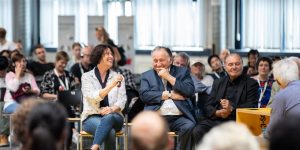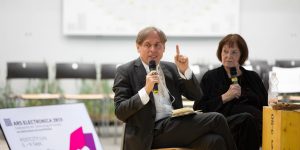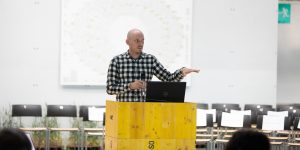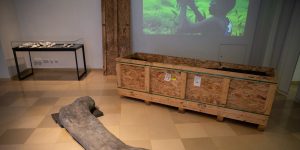history

Origin
Refik Anadol (TR/US)
Origin is an immersive installation that narrates the incredible cultural and scientific legacy of Ars Electronica. Using archival information from the past 40 years, this piece aims to tell the story not only the story of the institutions’ foresight and innovation but also use this history to visualize future trends and realities.

Ars Electronica History Day
The History Day conferences are dedicated to the anniversary celebrations of Ars Electronica. After 40 years in existence, we reflect on the various forms of digital media art that emerged during this time and were embedded and presented in the festival. Pioneers of artistic movements with strong impacts on the digital revolution from all around the globe will discuss outstanding ideas, practices and contributions from the intersection between art and technology.

Japanese Media Art Timeline Infographics Project
Atsuhito Sekiguchi(JP), Hiroko Myokan(JP), Minoru Noma (JP), Keiko Kobayashi (JP), Ryoji Tanaka (JP)
We are trying to build a history of Japanese media art from the event, with the artistic support of company Mesena (mécénat) and through the student-teacher relationships at the educational research institute. It will consist of an infographic that clearly displays the relationship between the winning projects at PRIX ARS Electronica and those at the Japan Media Art Festival.

Ars Electronica History Summit
THU 5.9. | 14:00 – 18:00

Telecommunications Art
THU 5.9. | 12:30 – 13:30

100 Jahre Bauhaus: We are not alone
THU 5.9. | 11:00 – 12:30: The panel introduces lecturers who in recent years have devoted themselves to arts education that straddles the humanities and the natural sciences. The experiences gained through this examination of science and art find expression in an original theory as well as in the artistic practice of students, sometimes over several generations. We would like to take the time for a critical inventory that not only leads to skepticism, but also to a change in the design of cultural technology. Teachers from various disciplines will explain approaches developed from the encounter of art practice and theory at art colleges. The focus is on the adventures and visions that manifest themselves 100 years after the euphoria of the Bauhaus.

Remake the Media History!
Martina Ivičič (SK)
Born online, new media art is like a cultural nomad aimlessly walking through the rhizomatic meanders of an archive without walls. It flickers back and forth in the annals of history and crosses geographic, cultural, and institutional boundaries, both physically and virtually. The aim of the subject The Best of New Media Art is to acquaint students with media art history in a similar way.

Fossil Futures
Nora Al-Badri (DE), Jan Nikolai Nelles (DE)
"Oskar" is what Germans affectionately call "their" Dino, the world's largest dinosaur skeleton, which is at home in Berlin's Museum of Natural History. Nora Al-Badri and Jan Nikolai Nelles tried to find out where it originally came from and how it finally landed here. They received little information from the public authorities, but with the help of leaked data, artificial intelligence and 3D scans, the history of the fossil could be reconstructed. The trail led to the south of Tanzania. Under German colonial rule, tons of petrified bones were found there and brought to Germany. Using state-of-the-art technology – including a "Virtual Reality Museum" – Fossil Future poses the question of stolen identity, cultural heritage and public property.


